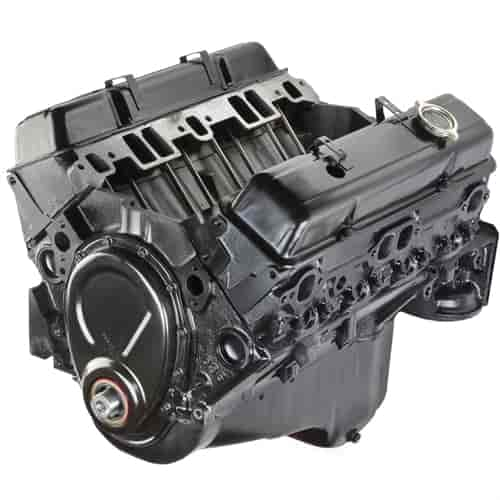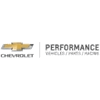Chevrolet Performance GM Goodwrench NEW 350ci Crate Engine 195 HP (Can produce up to 260 HP)
809-12681429









| Ratings |
|---|
| Price |
| Brand |
Crate Engine
Specifications
- 4-bolt main with a 2-piece rear main seal
- Nodular iron crankshaft
- 4.000'' bore x 3.480'' stroke
- Internal balance
- LT1/LT4 powdered metal connecting rods
- Cast aluminum pistons (dished)
- 8.5:1 compression ratio
- Hydraulic flat tappet cam (.383"/.401" Lift, 194 / 202 Duration @ .050", and 112° lobe separation)
- Cast iron cylinder heads with 76cc chambers
- 1.940'' Intake / 1.500'' Exhaust valves
- 1.250'' diameter valve springs
- 1.5:1 ratio rocker arms
- 3/8'' pressed-in rocker studs
- Block is compatible with left or right side oil dipstick (plugs for unused side included)
- 4-quart oil pan
- Oil pump, oil pump pickup and oil pump drive shaft installed
- Includes timing tabs for a 6-3/4" or an 8" balancer (balancer not included)
- Recommended spark plug: 14mm thread, .460" reach, 5/8" hex, tapered seat, projected tip (AC Delco p/n 065-R45TS, Autolite p/n 417-144)
- Not Intended for Marine Use
- Requires p/n 809-19299222 or p/n 555-23605 Oil filter adapter (not included)
- Not Intended for Marine Use
- No core charge
Major Components NOT Included: - Starter
- Flexplate/Flywheel
- Harmonic Balancer & Bolt
- Water Pump
- Intake Manifold
- Carburetor
- Fuel Pump
- Fuel Pump Pushrod
- Distributor
- Spark Plugs & Wires
- Oil & Filter
- Gaskets
- Motor Mounts
Engine Break-In Procedure
Use conventional or break-in oil (non-synthetic) for the first oil change, be sure to check the oil level in the engine and prime the oil system with an engine priming tool.
Engines with flat tappet hydraulic cams only - Run the engine between 2,000 and 2,500 RPM's, with no-load on the engine for the first 30 minutes. This is critical to break in the camshaft.
Drive the vehicle with varying speeds and loads on the engine for the first 30 miles. Be sure not to use a lot of throttle or high RPM. Run five or six medium-throttle accelerations to about 3000 RPM (40 to 50 MPH), then letting off in gear and coasting back down to 20 MPH. Run a couple of hard throttle accelerations up to about 5000 RPM (55 to 60 MPH), then letting off in gear and coasting back down to 20 MPH.
Let the engine cool and change the oil and filter using conventional (non-synthetic) oil and check coolant level, top off if necessary. Drive the next 500 miles normally, without high RPM's (below 5000 RPM), hard use, or extended periods of high loading. Change the oil and oil filter again using conventional (non-synthetic) oil. Keep an eye on oil level during the first thousand or so miles.
It would be suitable to use synthetic motor oil after the second recommended oil change and mileage accumulation.
Looking to do an R&R with my 1989 firebird formula 350. I'm just wondering if it would be a simple pull out, bolt on the accessory components on this engine, and put the new one in without having to buy an extra kit or anything. Are there any suggestions?
Camshaft specs for this engine shown as 194/202 duration & .383"/.401" lift however, these specs do not match anything in the list of factory camshafts. I was wondering if this was a typo or if you can provide a part number for this cam.
Does jegs provide a list of parts recommendations for the major parts not included with this engine?
What is the optimal cruising RPM of this engine?
Does the 12681429K kit work with this block?
What is the recommended oil for this engine? I live in Florida. 90+ degrees 8 months of the year.
Will this engine work in a 1960 Corvette
will the fit a 2007 impala ss if not can you direct me to 1 thats does thanks.
Motor Vehicles
WARNING: Motor vehicles contain fuel, oils and fluids, battery posts, terminals and related accessories which contain lead and lead compounds and other chemicals known to the State of California to cause cancer, birth defects and other reproductive harm. These chemicals are found in vehicles, vehicle parts and accessories, both new and as replacements. When being serviced, these vehicles generate used oil, waste fluids, grease, fumes and particulates, all known to the State of California to cause cancer, birth defects, and reproductive harm.
Tools:
WARNING: Some dust created by power sanding, sawing, grinding, drilling, and other construction activities contains chemicals known to the State of California to cause cancer and birth defects or other reproductive harm. Some examples of these chemicals are: lead from lead-based paints, crystalline silica from bricks and cement and other masonry products, and arsenic and chromium from chemically treated lumber. Your risk from exposure to these chemicals varies, depending on how often you do this type of work. To reduce your exposure, work in a well-ventilated area and with approved safety equipment, such as dust masks that are specially designed to filter out microscopic particles.
Electrical Cords
WARNING: The wires of these products contain chemicals known to the State of California to cause cancer and birth defects or other reproductive harm. Wash hands after handling.
